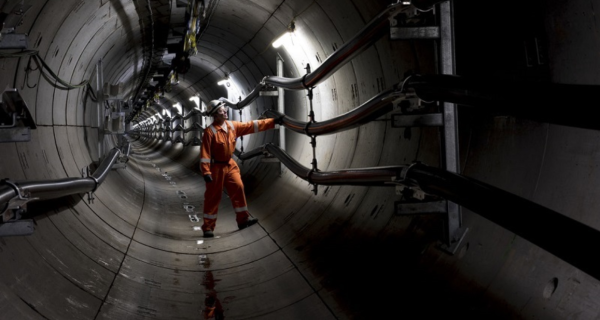How Britain can manage risk better to deliver world-class infrastructure
From working more collaboratively to learning from other players in the sector, the built environment could free up resources to enable innovation.

|
| London Power Tunnels takes a pioneering approach to delivery. Image credit: National Grid |
Contents |
[edit] Introduction
In a changing and growing world full of competition, standing still is not an option.
As new economic focal points arise around the world, as capital becomes increasingly mobile, and as companies compete more frequently outside of their home markets, the opportunities for British built environment professionals to deliver world-class infrastructure have never been greater. What's holding us back, however, is the risk of risk.
ICE has produced a short briefing paper, ‘Improving approaches to risk in the built environment sector’, to serve as a reference point for decision makers and promote discussion in the sector on how we can manage risk better.
It draws on the principles for developing new business models that have been set out as part of Project 13, a blueprint for the sector on how this could be achieved, designed by ICE and the Infrastructure Client Group.
[edit] A risky business
Risk is an everyday issue in any economic undertaking. Adopting an approach which manages project risk effectively, however, is an acute problem in construction and the built environment.
The mindset towards risk is inherently conservative. This is understandable given how dangerous the work can be and because of how competitive the market is.
While this means that the UK has cost-conscious contractors who deliver excellent infrastructure at value, over the longer term, this has resulted in an industry constantly under pressure to seek a margin.
[edit] Taking responsibility
This transactional approach has wider effects which undermine the industry’s fundamentals.
With no economic margin comes no development of skills, no room to research, no ability to test bed innovations and an unwillingness to try new things – all through fear they will not work.
What's needed are changes in business practices. Working collaboratively through an enterprise model (instead of treating partners on a project as separate entities to be managed), could have great benefits for the sector. The costs of risk are substantial, up to 50% of the final price paid by the asset owner.
If management and ownership of risk were kept where they can best and most expertly be handled, rather than pushed around, resources could be freed up which could improve the financial health of the sector and free up resources to improve practices and enable innovation.
[edit] Working together, learning together
Beyond business practices, different players in the sector would do well to learn from each other. Internationally companies are adopting new ways of working and building using cutting-edge technology like 3D printing on a scale that the UK isn't accustomed to.
Data is also vital, and can be harnessed through adopting shared frameworks. Indeed, simple standardised methods of measuring project outcomes could enable more straightforward lesson-sharing, avoiding the pitfalls projects have come across and adopting what works.
Pulling together as a sector, with clients and contractors setting aside funds from projects to allow for sector-wide dedicated budgets for research, innovation and skills development would also create space to test ideas outside of active projects.
The result of which would remove some of the concern about projects failing because of new and not well-understood techniques.
[edit] A positive outlook
The UK has an enviable reputation in project management, implementation of safe working and providing long-lasting, safe infrastructure. It's important that the government and the sector shout about these successes while also casting a critical eye over things when they go wrong.
Overall, what's needed is teamwork and evolution to minimise the impact of risk on the successful delivery of programmes and projects.
You can download the briefing paper here: https://www.ice.org.uk/ICEDevelopmentWebPortal/media/Documents/Media/Policy/Improving-approaches-to-risk.pdf
This article was originally published by the Institution of Civil Engineers on 5 December 2018. It was written by ice.org.uk Martin Shapland, ICE Policy Manager. Ref https://www.ice.org.uk/news-and-insight/the-infrastructure-blog/december-2018/improving-approaches-to-risk-in-built-environment
--The Institution of Civil Engineers
[edit] Related articles on Designing Buildings
Featured articles and news
The UK's Modern Industrial Strategy: A 10 year plan
Previous consultation criticism, current key elements and general support with some persisting reservations.
Building Safety Regulator reforms
New roles, new staff and a new fast track service pave the way for a single construction regulator.
Architectural Technologist CPDs and Communications
CIAT CPD… and how you can do it!
Cooling centres and cool spaces
Managing extreme heat in cities by directing the public to places for heat stress relief and water sources.
Winter gardens: A brief history and warm variations
Extending the season with glass in different forms and terms.
Restoring Great Yarmouth's Winter Gardens
Transforming one of the least sustainable constructions imaginable.
Construction Skills Mission Board launch sector drive
Newly formed government and industry collaboration set strategy for recruiting an additional 100,000 construction workers a year.
New Architects Code comes into effect in September 2025
ARB Architects Code of Conduct and Practice available with ongoing consultation regarding guidance.
Welsh Skills Body (Medr) launches ambitious plan
The new skills body brings together funding and regulation of tertiary education and research for the devolved nation.
Paul Gandy FCIOB announced as next CIOB President
Former Tilbury Douglas CEO takes helm.
UK Infrastructure: A 10 Year Strategy. In brief with reactions
With the National Infrastructure and Service Transformation Authority (NISTA).
Ebenezer Howard: inventor of the garden city. Book review.
The Grenfell Tower fire, eight years on
A time to pause and reflect as Dubai tower block fire reported just before anniversary.
Airtightness Topic Guide BSRIA TG 27/2025
Explaining the basics of airtightness, what it is, why it's important, when it's required and how it's carried out.
Construction contract awards hit lowest point of 2025
Plummeting for second consecutive month, intensifying concerns for housing and infrastructure goals.
Understanding Mental Health in the Built Environment 2025
Examining the state of mental health in construction, shedding light on levels of stress, anxiety and depression.






















